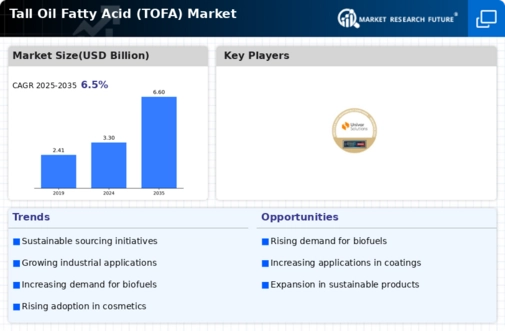Top Industry Leaders in the Tall Oil Fatty Acid Market
 Tall Oil Fatty Acid (TOFA), born from the humble leftovers of wood pulp production, is quietly rewriting the script of sustainability and performance in an array of industries. This versatile, bio-based oil, extracted from the "liquid rosin" or tall oil generated during pulping, is emerging as a formidable alternative to traditional fossil-based fatty acids, fueling a dynamic and competitive landscape. To navigate this exciting market, a discerning eye is needed to decipher the strategies at play, the factors driving market share, and the recent developments shaping its trajectory.
Tall Oil Fatty Acid (TOFA), born from the humble leftovers of wood pulp production, is quietly rewriting the script of sustainability and performance in an array of industries. This versatile, bio-based oil, extracted from the "liquid rosin" or tall oil generated during pulping, is emerging as a formidable alternative to traditional fossil-based fatty acids, fueling a dynamic and competitive landscape. To navigate this exciting market, a discerning eye is needed to decipher the strategies at play, the factors driving market share, and the recent developments shaping its trajectory.
Market Share: A Symphony of Sustainability and Performance
Several key factors orchestrate the dance for market share in this eco-conscious arena:
-
Sustainability Appeal: TOFA's renewable origin and lower carbon footprint resonate with consumers and brands alike, offering a green edge over petroleum-derived alternatives. This aligns with global sustainability goals and drives market adoption. -
Performance Benefits: TOFA boasts several impressive properties, including high-oleic acid content for improved stability, excellent lubricity, and potential for biopolymer and biofuel production, making it a versatile and efficient ingredient. -
Cost Competitiveness: Advancements in extraction and processing technologies are driving down TOFA production costs, making it increasingly price-competitive with traditional options, further boosting its appeal. -
Regional Dynamics: Asia-Pacific, particularly China and India, leads the charge due to booming construction and infrastructure sectors, where TOFA finds applications in paints, coatings, and lubricants. Europe and North America also witness significant growth, fueled by environmental regulations and a shift towards bio-based products.
Strategies for Tall Oil Triumph: Mastering the Green Gold Rush
Market leaders are wielding a potent arsenal of strategies to outmaneuver their rivals:
-
Vertical Integration: Securing control over the entire value chain, from sourcing wood pulp to processing and distribution, ensures quality, cost control, and agility. Companies like Foreverest Resources and Eastman Chemical are actively integrating upstream and downstream. -
Product Development: Continuous research and development in advanced TOFA derivatives and specialty applications opens doors to new markets and premium segments. IOP and Florachem are leading the charge in product innovation. -
Strategic Partnerships: Collaboration with research institutions, universities, and end-user industries fosters innovation and accelerates application development. Westrock and Harima Chemical Associates actively partner with diverse stakeholders. -
Sustainability Focus: Implementing green practices, like minimizing waste and using renewable energy in production, aligns with customer preferences and regulatory requirements. Chemical Associates and OOO Torgoviy Dom Lesokhimik are showcasing their commitment to sustainable practices.
Key Players
- PineChemical Group Oy (Finland)
- Forchem Oyj (Finland)
- Kraton Corporation(US)
- Univar Solutions (US)
- Ilim Group JSC (Russia)
- DRT (Derives Resiniques ET Terpeniqes) (UK)
- Harima Chemicals, Inc (Japan)
- Eastman Chemical Company (US)
- OOO Torgoviy Dom Lesokhimik (Russia)
- Lascaray S.A. (Spain)
- Georgia-Pacific Chemicals LLC (US)
- Industrial Oleochemical Products (South Africa)
Recent Developments:
-
September 2023: Researchers at MIT develop a novel catalytic process for converting TOFA into high-value chemicals like nylon precursors, potentially unlocking new revenue streams for the industry. -
October 2023: Arizona Chemical introduces a new line of eco-friendly paints and coatings formulated with TOFA, catering to the growing demand for sustainable construction materials. -
November 2023: The US Environmental Protection Agency approves TOFA-based biolubricants for use in marine engines, paving the way for cleaner shipping practices. -
December 2023: A team at Stanford University creates bioplastics using TOFA as a key ingredient, offering a viable alternative to petroleum-based plastics and reducing reliance on fossil fuels.

